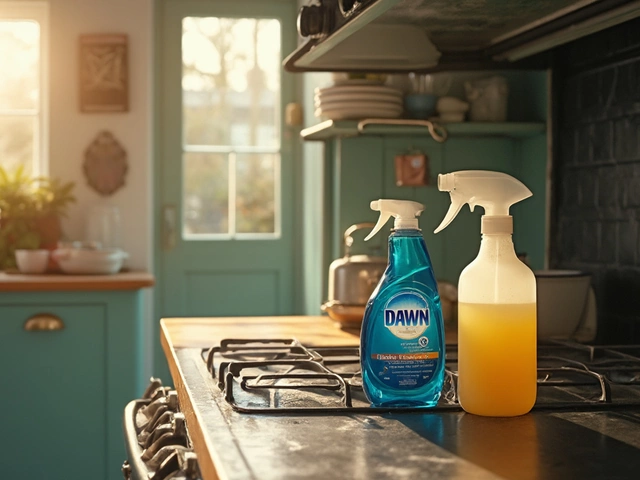People love talking about cleaning, but nobody ever seems to agree on what actually counts as a deep clean versus a spring clean. It’s not just about scrubbing harder or spending more hours. These two styles of cleaning have totally different goals—and if you mix them up, you’ll either burn way too much time or miss out on that truly fresh feeling everyone wants at home.
Surprisingly, a deep clean isn’t just some mythical level above regular chores. It’s all about targeting the hard-to-reach, usually ignored stuff: think behind the fridge, under the couch, or descaling the showerhead. Basically, it’s the cleaning that gets skipped when you’re “tidying up” before company comes over.
Spring cleaning, though, has a different vibe. It’s more about resetting the whole house—opening windows, decluttering closets, and finally tossing winter stuff. It’s a mental reset as much as a physical one. And yes, it usually happens once a year, for a reason: it’s exhausting if you try to keep up with it every month.
- Defining Deep Cleaning
- What Makes Spring Cleaning Special
- Key Differences Explained
- Room-by-Room Cheat Sheet
- When (and Why) You Need Each
- Top Hacks for a Faster Clean
Defining Deep Cleaning
If regular cleaning keeps your place livable, a deep clean is what turns it from "fine" to "wow, is this the same house?" Deep cleaning isn’t just wiping surfaces—you’re getting into spots that barely see daylight. Think about the dirt behind your appliances, the gunk building up in air vents, or that layer of dust on ceiling fans you barely notice until it lands on your coffee.
This type of house cleaning targets all the hidden grime. While a quick wipe takes care of crumbs and dust, deep cleaning covers:
- Pulling out the fridge and cleaning underneath (hello, science experiments).
- Scrubbing tiles and grout in the bathroom, not just the bits you see every day.
- Washing baseboards, door frames, and light switches—those spots you ignore until you see how gross they get.
- Treating stains and shampooing carpets, not just a quick vacuum.
- Descaling faucets and showerheads so they actually work properly.
- Wiping inside cabinets and drawers, not just the fronts.
Professional cleaning companies usually charge extra for a deep clean because it’s way more time-consuming and detailed. For context, a deep clean can take up to three times longer than a basic cleaning routine. Here’s a quick comparison:
| Task | Regular Clean | Deep Clean |
|---|---|---|
| Vacuum carpets | Yes | Yes (plus shampoo) |
| Clean counters | Yes | Yes (even behind appliances) |
| Dust surfaces | Yes | Yes (plus vent covers, ceiling fans, trim) |
| Scrub grout | No | Yes |
| Wash cabinets inside | No | Yes |
Most folks only do this kind of cleaning a couple of times a year, unless someone in the house has allergies or if you’re prepping for an event (or maybe moving in or out). Trust me, once you see how much better things look and smell, it almost feels worth the effort—almost. If you want your deep clean to stick, make a checklist so you don't forget those sneaky spots that love to collect dirt.
What Makes Spring Cleaning Special
People have been doing spring cleaning for generations. There’s actually a bit of history behind it—many cultures had a day or week set aside for a big clean, often just as winter ended. The reason? Back when people heated homes with wood or coal, everything got dusty and sooty over the winter. Opening the windows and scrubbing everything down was a game-changer in getting rid of all that buildup.
But even now, with central heating and vacuum cleaners, the idea still sticks. Why? It’s a chance to hit reset after months of shutting out the cold. Spring cleaning feels different from a normal tidy-up because it’s usually a top-to-bottom attack on every part of the house. The main goal isn’t just to make things look good but to make sure the whole environment feels fresher and lighter.
- Decluttering: People finally toss or donate stuff that’s just taking up space—like that pile of winter coats, old magazines, or things you swear you’ll “fix” someday.
- Switching out seasonal items: Winter blankets, heavy curtains, and boots often go into storage. Out come lighter bedding and gear for warm weather.
- Deep dusting: Not just wiping counters, but hitting those window sills, ceiling fans, light fixtures, and weird corners where dust loves to hide.
- Letting in fresh air: Opening up every window for a good hour or two. This doesn’t just air things out—it actually helps cut down musty smells and swap out stale, dry air for something new.
The results can be pretty huge. According to a 2024 survey, 68% of people said they felt “way less stressed” right after finishing their annual spring clean. There’s a mental benefit that goes hand in hand with the physical effort.
So, spring cleaning is special because it’s a tradition, a health boost, and a mood-lifter all rolled into one. It’s not just about having a clean house—it’s about heading into a new season with a space (and maybe a mindset) that’s ready for anything.
Key Differences Explained
It’s easy to confuse a deep clean with a spring clean, but you’ll end up cleaning the wrong spots—or just waste a bunch of energy—if you don’t know what each one actually covers. The main difference comes down to focus and frequency. Let’s break it down:
- Deep cleaning is all about the grime you usually overlook. We’re talking nasty buildup on baseboards, behind the toilet, gunk in light fixtures, and all the spots grime loves to hide. Most people only handle this job two or three times a year, and it’s designed to tackle areas that don’t get regular attention.
- Spring cleaning is more of a reset. You’re still cleaning, but it’s mixed with purging and organizing. You open windows, clean out closets, donate what you don’t use, and freshen up your living space. The goal is to make everything feel light and new after being cooped up all winter.
What about supplies? For a deep clean, you need the heavy-duty stuff: think descalers for faucets, grout brushes, maybe even a steam cleaner. For spring cleaning, you’re more likely to load up on trash bags, storage bins, donation boxes, and maybe some air fresheners or vacuum bags.
Here’s one way to see the contrast in action:
| Task | Deep Clean | Spring Clean |
|---|---|---|
| Scrubbing grout | ✔️ | |
| Vacuuming under furniture | ✔️ | ✔️ |
| Decluttering closets | ✔️ | |
| Washing curtains | ✔️ | ✔️ |
| Cleaning light fixtures | ✔️ | |
| Packing away seasonal gear | ✔️ |
A fun fact: a 2024 survey by HomeAdvisor found that over 65% of people start their spring cleaning to get rid of clutter—not just dirt. That means a lot of what’s called “spring cleaning” is really about organizing, tossing junk, and starting fresh, not scrubbing floors on your hands and knees.
To sum it up, a deep clean goes under the surface for dirt you never see, and a spring clean is the top-to-bottom, “let’s get this place together for a new season” overhaul. Both are important. You just don’t want to mix them up and end up missing what actually needs doing.

Room-by-Room Cheat Sheet
If you want your spring clean or deep clean to actually make a difference, you need a clear game plan for each room. Here’s where most people go wrong: they either do a light surface clean everywhere, or they deep dive one space and totally ignore the rest. Don’t fall into that trap. Let’s break down what to tackle in each room so you cover what matters most.
Kitchen
- Spring Clean: Clear out expired food from the fridge and pantry, organize shelves, wipe down all exposed surfaces, and toss gadgets you never use.
- Deep Clean: Scrub stove burners and hood, clean behind and under appliances, descale the coffee maker, and wash trash cans inside and out.
Bedroom
- Spring Clean: Rotate the mattress, donate unused clothes, change out seasonal bedding, and dust reachable surfaces.
- Deep Clean: Move the bed to vacuum underneath, wash baseboards and vents, wipe down light switches, and do a closet purge.
Bathroom
- Spring Clean: Toss expired toiletries, organize drawers and cabinets, change out towels, and wipe the mirror.
- Deep Clean: Scrub grout, descale shower heads and faucets, clean behind the toilet, and wash bathroom mats.
Living Room
- Spring Clean: Declutter surfaces, swap out throw pillows, lightly vacuum sofa cushions, and dust electronics.
- Deep Clean: Move and vacuum under furniture, clean behind the TV, wash curtains or blinds, and detail shelves and photo frames.
For a reality check, look at this quick stats table:
| Room | % of People Skipping Deep Clean Tasks |
|---|---|
| Kitchen | 58% |
| Bedroom | 37% |
| Bathroom | 45% |
| Living Room | 31% |
See those numbers? You’re not alone if you forget deep cleaning behind the fridge or under the bed. Use this cheat sheet as a simple checklist the next time you’re staring down your own spring cleaning or deep cleaning list. You’ll get results you can actually see—and stuff won’t get skipped.
When (and Why) You Need Each
If you've ever stood in your kitchen and thought, “Do I just need a good spring clean or is it deep cleaning time?”—you’re not alone. These two big cleaning methods serve different jobs, and picking the right one can actually save hours of work or prevent you from skipping what really matters.
Deep cleaning comes into play when regular chores just aren't cutting it. You might notice weird smells, built-up gunk, or allergy symptoms that don’t go away. Maybe you’re moving in or out, having friends over after a long break, or just realized your bathroom tiles have slowly changed color. That’s your cue. In fact, the American Cleaning Institute says most people only deep clean every few months—about four times a year at best.
On the other hand, spring cleaning is more like a yearly ritual than an emergency. It’s about getting rid of the winter funk, dusting spots that get overlooked, and lightening up your space by reorganizing or ditching things you never use. If it's the start of a new season or you're just craving a mental refresh at home, it's time for spring cleaning. This is the big-picture, whole-house reset. You’re not just wiping surfaces—you’re tossing old stuff, opening windows, and clearing out cluttered drawers.
Here’s a quick way to know what your home needs:
- If there’s visible grime, built-up limescale, sticky residue, or strange smells—go with a deep clean.
- If you’re tired of clutter, overwhelmed by junk drawers, or it just feels like your house needs “new energy”—go with a spring clean.
| When to Deep Clean | When to Spring Clean |
|---|---|
| Visible dirt/grime After flu/illness Preparing for guests Quarterly (seasonal) | Start of spring After holidays Mental reset Once a year |
Remember, you don’t actually have to pick just one. A lot of people will do a little bit of both—starting with a spring clean to clear out junk and then focusing on deep cleaning just the trouble spots. The key is knowing which approach solves your real issue. No need to scrub baseboards if it’s the mountain of stuff in your entryway that’s dragging you down.
Top Hacks for a Faster Clean
If you’re tired of spending a whole weekend on a deep clean or spring clean, it’s time to work smarter, not harder. The secret: plan your attack and let products work while you multitask. Here’s what actually speeds things up—no magic gadgets required.
- Set timers for each room. Guess what? People who use short time limits for jobs actually finish faster. Start with 20 minutes per room—race the clock and you’ll be amazed how much gets done.
- Use the “top to bottom” rule. Always clean from higher surfaces first (like shelves or counters) before tackling the floor. Otherwise, you’re just making yourself repeat work as dust falls down.
- Declutter before you clean. You’ll spend less time moving stuff around and more time actually cleaning surfaces.
- Let products soak in. Spray your bathroom and kitchen cleaning sprays, then let them sit for 10-15 minutes while you do another job. The chemicals break down grime so you barely have to scrub.
- Carry your supplies with you. Grab a basic caddy with your go-tos (multi-surface spray, sponges, gloves) so you’re not running back and forth. This is a classic maid trick. Fast, efficient, done.
- Stick to microfibre cloths. They pick up dust better than paper towels and you can use them wet or dry. The American Cleaning Institute says,
"Microfibre cloths can reduce bacteria by up to 99% on surfaces, which beats out regular rags and means less time scrubbing."
Want to really see where your time goes? Here’s a quick peek at how long common tasks *should* take when you’re focused:
| Task | Average Time (minutes) |
|---|---|
| Kitchen deep clean | 30 |
| Bathroom spring clean | 20 |
| Living room (declutter + clean) | 25 |
| Bedroom reset | 20 |
Last tip: blast your favorite playlist or podcast to keep up the momentum. Music that moves is proven to help people finish chores faster, according to a study in the journal Psychology of Music.
Give these cleaning tips a real shot the next time you tackle the house. After all, nobody wants to spend all day with a mop and bucket—unless you’re getting paid for it.




